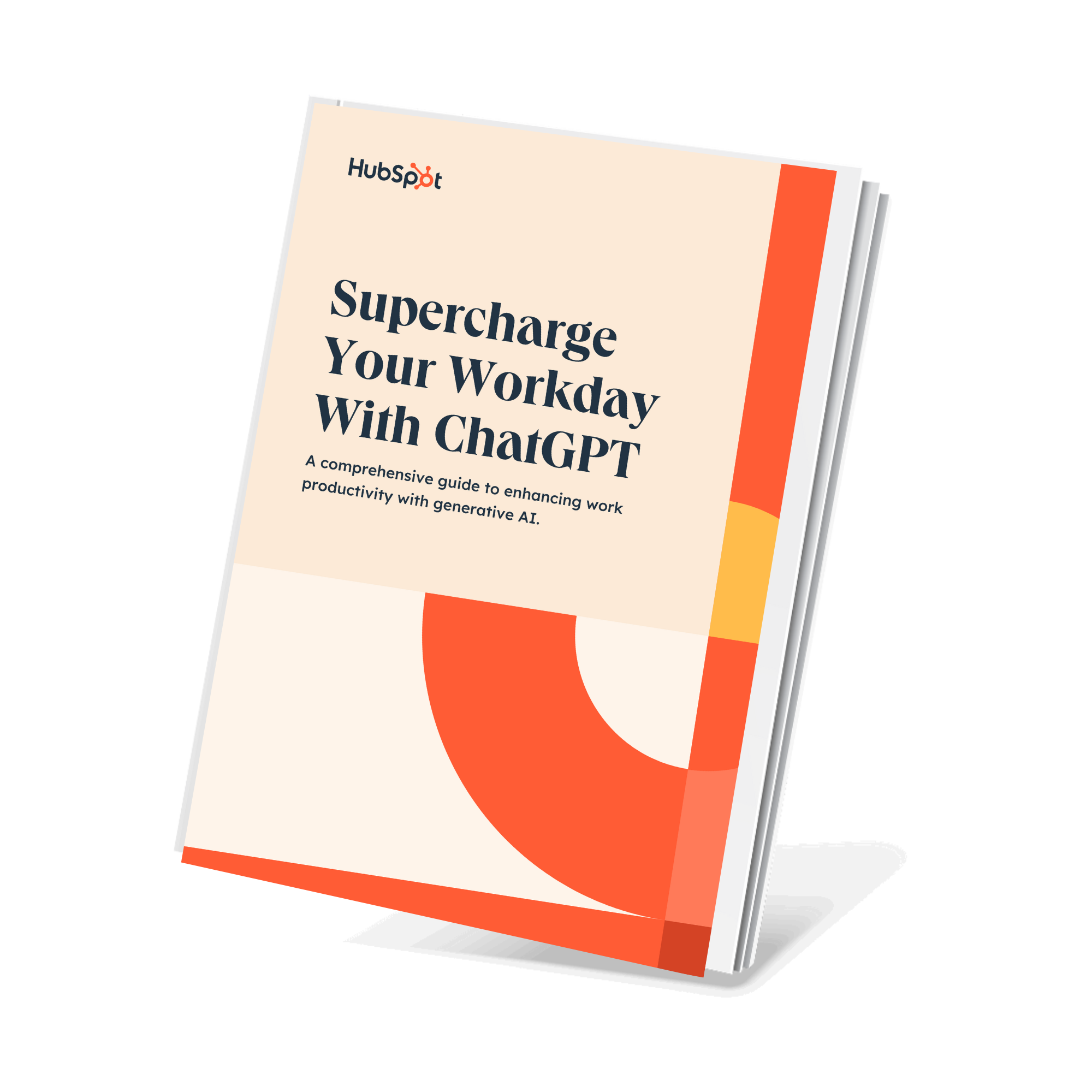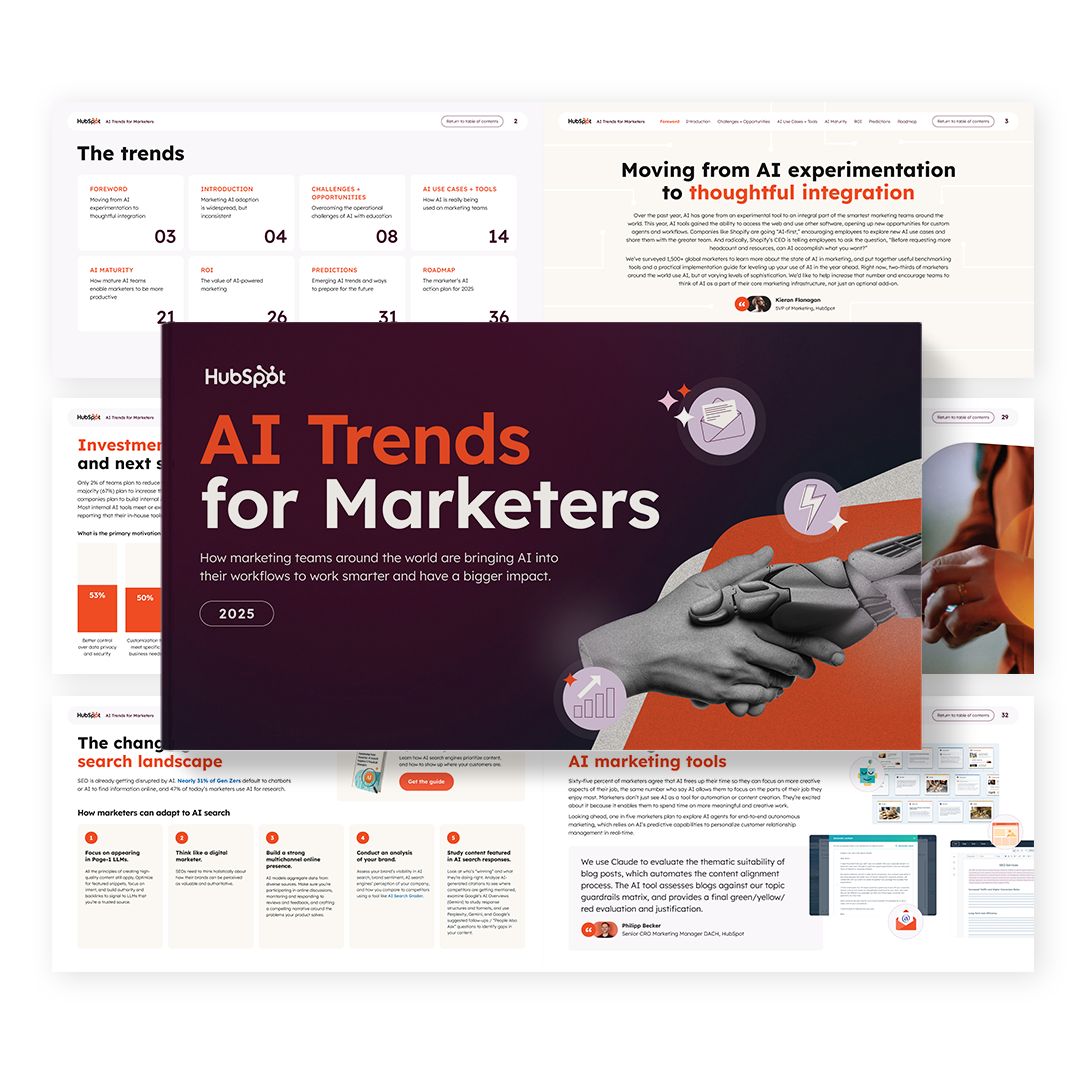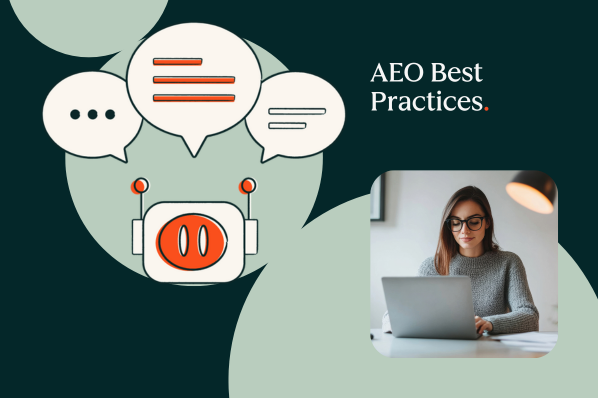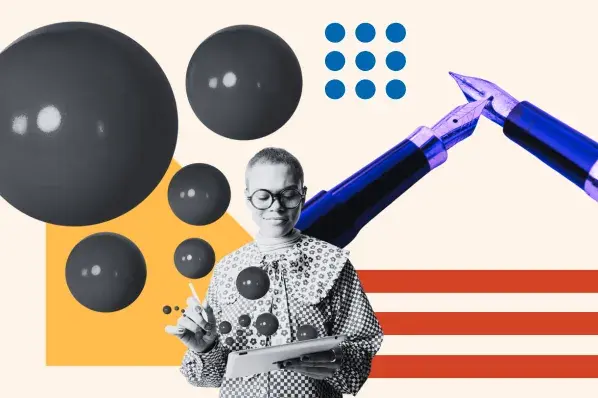Turns out, I was wrong. With the help of AI tools, I got the name, slogan, and brand color suggestions in just a few minutes, and they were all stunning (more on this later).
So, in this piece, I’ll show you how AI can benefit your small business, going far beyond just communication and content creation. Let’s dive in.
How AI Can Level Up Your Marketing
There are so many different ways that AI can improve your marketing, and the list could probably include more than 100 ways, but I’ll show you the 12 greatest.
1. Speeding Up Content Writing
79% of marketers believe that AI improves the quality of the content they create. And I totally agree. AI has changed content marketing in a very positive way (of course, only for those who know how to use it properly).
Struggling with writer's block? AI can analyze trends and suggest engaging content ideas which is the top reason why many marketers use AI, according to our study.
It can also automate repetitive tasks such as generating SEO descriptions and social media posts.
Additionally, AI can improve content by checking grammar, spelling, and sentence structure to ensure clarity and professionalism. Some AI assistants, like Jasper, can even adapt their writing style to match your desired tone.
But remember, none of these tools are plug-and-play solutions. You still need creativity and solid writing skills. Otherwise, the content might sound off, and readers will notice it's AI-generated. So, be ready to tweak and refine.
Pro tip: We have a free content assistant ChatSpot, which combines the power of ChatGPT with unique data sources like HubSpot CRM to streamline your working day.
2. Automating Personalized Offers
Personalization isn‘t just about sending generic birthday coupons anymore.
You need to understand each customer’s preferences and then craft special offers just for them. Even though it may seem like a mountain of work, AI can swoop in to save you.
Based on customer data, AI can personalize your marketing content, recommendations, and offers for each individual customer.
This can significantly improve CTRs, conversion rates, and, most importantly, customer satisfaction. To prove how AI can help with personalization, I explored a bit and found a great case study.
U.S. Beauty retailer Ulta Beauty benefited from SAS Customer Intelligence 360, which combined all their data and sent personalized messages and recommendations to each customer.
The outcome? A massive win. Ulta Beauty's sales went through the roof — an incredible 95% of their sales were influenced by their personalized marketing efforts.
Pro tip: Always analyze customer sentiment during the checkout process. If you notice they’re hesitant, let your AI suggest a less pushy and more intriguing CTA like “Are you sure you need me? Let’s find out” instead of “Buy Now.” This subtle shift can address purchase anxieties and improve conversion rates.
3. Analyzing Customer Behavior
AI is seriously good at sifting through massive amounts of customer data — website visits, app interactions, social media activity, purchase history, email clicks, and more.
It can map out the different touchpoints customers interact with on their way to making a purchase, so you can identify any roadblocks or friction points in the customer journey.
It can also analyze customer purchase history to identify products that customers are likely to buy together. You can use this information to create targeted upsell and cross-sell campaigns that increase the average order value.
One pretty good tool for this purpose is Adobe Customer Journey Analytics, which provides insights into customers' journeys across channels — online and offline. It offers connected data and unlimited customer data collection. And you can get contextual insights instantly, which is a huge plus.
Pro tip: Give a try to HubSpot's Behavioral Targeting tool to create segmented lists based on personas and engagement levels. Plus, the tool helps identify and respond to high-intent behaviors like website visits, email interactions, and form submissions.
4. Predicting Audience Behavior
One of the best things about AI is its ability to predict audience behavior and pinpoint customers who are super interested in taking some action or those who are at risk of churning (canceling a subscription or stopping using your service).
For instance, Google Analytics and its Predictive audiences are great for this purpose. Predictive audiences help target users likely to take specific actions, like making a purchase soon.
It includes users with high probabilities of performing specific actions. For instance, “Likely 7-day purchasers” include those with high purchase probabilities. Adding extra conditions can refine the audience even further.
Pro tip: Partner with industry experts and trend forecasters to develop “what-if” scenarios for your customer journey. Explore potential disruptions, changing customer expectations, or even the impact of new technologies.
5. Automating Email Campaigns
Email marketing automation has been around for a while, but new AI tools are making it even better.
They can help you write more interesting emails and understand what your subscribers like. This lets you spend less time planning and more time running successful campaigns.
Here’s how AI can help you with emails:
- Analyzes user data to send targeted messages that resonate, boosting open rates and clicks.
- Checks historical data and subscriber behavior to predict the optimal send time, so your emails land in inboxes when recipients are most likely to open and engage.
- Automates A/B testing of various email elements like subject lines, CTAs, and design layouts to identify the best versions for future campaign
- Analyzes your email content and flag potential spam triggers, so you can avoid landing in the dreaded junk folder.
- Identifies subscribers at risk of unsubscribing and creates personalized re-engagement campaigns to win them back.
Pro tip: HubSpot's AI assistant can create an email that grabs attention and gets your subscribers clicking through to your content. It crafts catchy subject lines, product descriptions, and even whole email drafts.
6. Conducting Research
Market research can be time-consuming and labor-intensive. That’s why 48% of marketers use generative AI for research. Here's how:
- No more legwork. AI automates boring tasks like sending surveys and sorting piles of responses.
- Mind reading (almost). AI can analyze social media posts, reviews, and surveys to understand the emotions and opinions hidden behind the words.
- Spotting hidden clues. AI can scan massive amounts of data to find trends and patterns that you might miss on your own.
- Seeing into the future (sort of). AI can analyze data to predict how customers might behave and what trends might emerge. This lets you make smarter decisions about products, campaigns, and where to invest your resources.
- Tailored questions for tailored answers. AI can personalize surveys and automatically create questions for different customer groups, which saves a lot of time.
Pro tip: HubSpot Service Hub offers access to awesome Customer Feedback Software, which helps you run surveys and gain insights into your customers' shopping habits. Plus, there are tons of ready-to-go survey templates, so you can quickly learn about your customers’ habits and preferences.
7. Transcription and Summarization
After having a brainstorming session with your marketing team, you definitely don’t want to spend time sifting through hours of recordings.
You need someone, or even better — something — to do it for you. That’s where AI transcription tools take the stage.
Actually, 63% of marketers use AI tools to take notes and summarize meetings.
Before adding such software to my toolkit (Notta is currently my fav), I was constantly scrambling to take notes, worried about missing something crucial.
This left me feeling overwhelmed, and frankly, I hated meetings altogether. Emails were my haven — clear, written communication where I could keep track of everything.
Now, I can be fully present in the discussion while, after the meeting, sorting all transcripts into clear text and bullet points.
Pro tip: Most AI transcription tools have the ability to summarize the entire transcript into bullet points to make it clearer and more organized. Also, if you need a specific word you can simply find it by typing it in the search bar.
8. Automating Social Media Management
To market your small business, you need to be active on social media and keep regular track of what’s going on there, which can be overwhelming.
That’s why you need AI-powered social media tools that offer a range of features to help you:
- Schedule posts efficiently. Plan your content calendar in advance and publish across all your social media platforms at optimal times.
- Craft engaging content. Generate content ideas, write attractive captions, and personalize posts for each platform.
- Gain audience insights. Track brand mentions, analyze customer sentiment, and identify trends to understand your audience better.
- Optimize ads. Improve your advertising efforts and identify relevant influencers for marketing campaigns.
Pro tip: HubSpot AI Social Media Post Generator refines post ideas, adjusts tone to match your brand, and helps create better posts in less time. You can also repurpose posts by channel and track the ROI of SM accounts.
9. Faster Video Creation
Out of 701 people we asked about their favorite content types, 45% said they like short videos like TikToks, while 24% prefer longer videos.
So, it’s clear — if you want your business to stand out, you need video content. But, for small business owners and startups, hiring professional videographers and editors can be a budget-breaker.
Luckily, AI tools for video creation are incredibly good.
They allow you to script, generate, and even edit videos without needing pro equipment or expertise. These tools turn your ideas into engaging visuals with features like text-to-video conversion and footage libraries.
Some popular options are InVideo, Lumen5, and Kapwing, all offering user-friendly interfaces and budget-friendly plans.
Pro tip: Avoid stock footage that screams “fake” and “boring.” Always film some of your content with a phone (it doesn’t have to be a pro camera), upload your clips, and then let the AI tool do its part of the work.
10. 24/7 Customer Support
Unlike human reps who need breaks and work limited hours, AI chatbots are tireless. They can answer customer queries and provide basic support anytime, day or night.
This is especially good for small businesses with limited staff or operating in global markets with different time zones.
We surveyed people to see how they feel about using AI chat for customer support on websites. It turns out that 25% always turn to web chat for help, while only 15% prefer sending direct messages.
The good thing about AI chatbots is that they’re trained to handle various FAQs and common issues.
For instance, a clothing store chatbot could answer questions about sizing, return policies, or order tracking.
AI bot will have all answers to these questions because they’re general and repetitive, so human reps can focus on more complex problems that require a personal touch.
Pro tip: You can build your AI chatbot using HubSpot's Free AI Chatbot Builder. Sweet spot? No coding skills required. Your chatbot will qualify leads, schedule meetings, and offer customer support round-the-clock. The best part? You can customize it to perfectly match your brand.
11. Intelligent Advertising
As a small business owner, the last thing you want is to throw money on ads that bring nothing. That’s why you should think about incorporating AI advertising tools. AI digs through information about past customers and website visitors.
It analyzes things like demographics (age, location) and browsing habits to understand who your ideal customer is.
With this customer profile in hand, it finds similar people on the web and personalizes your ads accordingly. Another way to use AI tools in advertising is for designing.
Kipp Bodnar, HubSpot's CMO, shared that using AI to design ads for subscriber growth slashed contact acquisition costs by 300%.
How A $25B Company Uses A.I. To 300x Their Marketing Results (#129)
A great AI advertising tool is AdCreative.ai, which helps generate high-performing ad creatives quickly. It provides insights, generates text and headlines, creates social media post creatives, and even produces super-quality videos for ads.
Pro tip: Involve consumers in your AI-powered advertising to ditch the cold, “robotic” feel. Encourage UGC through contests or challenges. Then feed the customer-created pics/videos to AI tools and watch the magic happen.
12. Search Engine Optimization
Last but not least, AI tools can help with SEO — not only for SEO content creation but also for keyword research, competitor analysis, and overall optimization.
For instance, here’s how HubSpot SEO tools can make “ranking climbing” easier:
- Get keyword recommendations to optimize your website content.
- Plan your content strategy by discovering relevant topics to target—those that resonate with your audience and boost search authority.
- Generate content ideas based on search popularity and competition.
- Track your website's SEO performance with detailed reports.
- Integrate with Google Search Console for even deeper insights.
- Scan your website with an SEO recommendations tool that shows improvement opportunities automatically.
- Use AI Blog Writer to generate engaging SEO posts from outlines or bullet points.
- Use the AI Search Grader to see how visible your brand is in AI-powered search engines and results.
Pro tip: Use AI Paragraph Rewriter to refresh existing content for relevance and engagement, extending its reach and effectiveness.
My Favorite AI Marketing tools
I love AI marketing tools, and I’m often impressed by them. I’ve tried so many different ones. And of those tools, here are my four favorites.
HubSpot Starter Customer Platform
Sure, I might sound a little biased here, but HubSpot’s Starter Customer Platform really is the one-stop shop for all your sales and marketing needs.
It’s a bundle of tools that includes features from all of HubSpot’s other products. That means you get access to more advanced versions of Hubspot’s free AI tools I already talked about, like the AI blog writer and chatbot builder — all under the same roof.
Plus, the platform comes with quite a few other smart tricks. Here’s an example of a web page I built with HubSpot’s AI website builder.

It took just under two minutes to set up. The web page is complete with CTA buttons and lead capture forms. All that’s left for me to do is to fill in the blanks, make a few tweaks of my own, optimize the web page using HubSpot’s built-in SEO suggestions, and that’s it.
Once published, I can use the Customer Platform’s other tools to automatically store data from lead capture forms in the CRM, set up personalized email campaigns, measure traffic analytics, and so much more.
ChatGPT Plus
My forever favorite is undoubtedly ChatGPT, especially its Plus version, which I can access even during peak times and get faster responses.
I always say that ChatGPT is the most versatile tool ever. I use it for all kinds of my projects.
- Need to sort out the messy data order? ChatGPT helps.
- Need to create an article outline? ChatGPT helps.
- Need to understand the overly complicated law? ChatGPT helps again.
- Need to proofread, reword, and find a creative angle? ChatGPT 4 helps here.
The most important thing to get the most out of ChatGPT is to give it the clearest possible directions so it can understand you and adapt to your writing style, tone of voice, or task.
Good prompts are key.
If you give it a good command, it will do a lot for you, and you’ll avoid generic words such as “unleash,” which the whole world is making a joke of. For instance, let me show you how I used it to invent the name for my shop.
Here’s the prompt I sent:
“I need some ideas for a unique name for my new merch brand. I‘ll sell clothes featuring personalized prints, capturing moments with family and friends that hold sentimental value. I want the name to be cute, maybe with ’charm‘ in it. But here’s something important: it has to be totally made up, invented, fictional, easy to remember, and sound nice. Give me some good words with all these qualities, please.”
The ChatGPT suggested many great ideas, but the winner was Charmaloo. I used it for my slogan as well, so here you can see the final result:
It also suggested using vibrant colors to grab attention and even provided color codes for me to choose from for my Insta feed. How amazing it all looks:
The LinkedIn post below shows just how great ChatGPT can be — it acted like a CEO. Yes, a real CEO. It made decisions on the brand name, product design, pricing, and even marketing strategy.
Read the whole post here.
Submagic
As someone who enjoys creating videos for both my social media and clients, Submagic has been a lifesaver.
The primary reason I chose it over perhaps some more popular names is that it supports 48 languages. As a bilingual person, I often need automatic captions in languages other than English.
The best part about Submagic is that it generates 98% accurate real-time captions in literally seconds to a few minutes, depending on the length of the video.
Most of the time, I don’t even have to edit anything after its job. Other times, there are just maybe a letter or two or some commas. But overall, it’s very, very good.
There is a great choice of different fonts, and it automatically adds relevant emojis, which is fantastic. This tool has saved me so much time. Now when I remember that I used to add subtitles manually, I could cry. Literally.
Grammarly
One of the tools I use on a daily basis is Grammarly, and I can‘t imagine living without its AI powers.
However, I’m not a big fan of it when it comes to suggestions. Sometimes, Grammarly offers corrections that actually disrupt the flow and tone of my content. I feel like its ideas throw off the vibe I'm going for.
So, I mainly use it to catch misspelled words and typos. Also, I love its phone app, which allows me to quickly fix mistakes in my messages as well.
Speaking of the app, I can't get enough of Grammarly’s coolest notifications I receive when fixing all the mistakes in my text. For instance, look how sweet this is:
Jasper
While ChatGPT offers a lot, Jasper is No.1 for my social media needs.
Its pre-built templates are fantastic. I simply pick the desired SM template, add a quick one-sentence explanation and bam — my post is ready with emojis and hashtags.
But the main reason why I love Jasper is its uncanny ability to “get me.” When I choose the desired tone of voice and adjust the parameters, Jasper nails it 8 out of 10 times.
It understands the nuance I'm going for—playful and conversational for Instagram or informative and authoritative for my LinkedIn. It really has a “feel” for that because you can teach it.
It also helps me with all video-related things, such as hooks, scripts, titles, and descriptions — basically everything needed to ensure my video starts off on the right foot and turns out excellent.
Fotor
You know that high-quality visual content has a profound effect on marketing, and it is also essential for someone like me who loves writing articles and running social media. A comprehensive photo editing software is very much needed.
Fotor has more than three hundred useful functions for photo editing and designing. It's easy to use and beginner-friendly. Especially, it is a multi-platform photo editing software that various systems are interoperable, such as Windows, Mac, iOS, and Android.

Flick's Iris
Flick’s AI Social Media Assistant, Iris is a great tool for small businesses because it can help automate social media marketing and save time. It can also help you create more engaging content and reach a wider audience.
Iris can help you craft a strategy, plan your content, write engaging captions, and discover top-performing hashtags. The tool also maintains an up-to-date library of all viral trends, which Iris guides you on how to create based on your specific business. Iris can be a valuable asset for small businesses looking to improve their social media marketing results. Flick’s AI Assistant Iris has helped 20000+ small businesses automate nearly 70% of their social media strategy, completely in their brand voice and style—giving small business owners consistency online and the ability to focus on other areas of their business.

Everyone needs AI.
Your small business needs the help of AI to move faster, smoother, and save time and money. But once you grow, you’ll still need it to continue growing, improving, and not falling behind.
And no, you don’t need to use it solely for business purposes.
As a small business owner, managing non-work-related activities and daily plans can be super challenging, right? AI can lend a helping hand with this, too.
If I had to choose just one tool that every small business owner should use, it's ChatGPT Plus. It can assist with planning, strategies, ideation, data extraction, content creation, and even coding and SEO.
And remember — the more good tools you have in your toolkit, the better, faster, and more productive you'll be, so you’ll have more time to enjoy the fruits of your business. So, don’t run away from AI — embrace it instead; it’ll pay off.
Artificial Intelligence




.png?height=613&width=1920)






-1-20250905-2237709%202.webp)

![I tested the top 14 AI chatbots for marketers [data, prompts, use cases]](https://53.fs1.hubspotusercontent-na1.net/hubfs/53/best-ai-chatbot_1.webp)
%20NEW%202025.webp)